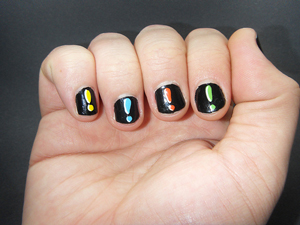
Source: Playdough Typeface - Punctuation Question Mark, Chank Diesel, Flickr
It might often seem that the sheer number of punctuation rules you have to learn could make you dizzy! Rules about where to place commas, how to punctuate the ends of sentences, whether a dash is the best choice, and so forth, may seem like too much to remember. At such times, recalling the purpose of punctuation—to help the reader understand what the writer really means—can be a good reminder.
When writing is read aloud, you can hear much of the punctuation. Punctuation marks indicate where the reader pauses, helping the listener clarify what is being said. It’s true that you cannot actually hear quotation marks, but you have learned, for example, to place these marks around anything that is spoken in dialogue or to emphasize a writer’s ironic or sarcastic tone, and these marks often come across when work is read aloud.

Source: Multicolour Exclamation, Neil Milne, Flickr
In this excerpt from Nsenga Burton's essay “It’s Here to Stay: The Bad, the Ugly, and Some Good” from the New York Times, we have replaced some of the punctuation marks below with a drop-menu. You just need to figure out the punctuation mark that best fits each sentence and choose your answer from the menu. We have included both the name of the punctuation mark and its symbol to help you.


Source: Karen, Star Guitar, Flickr
How did you do? Many punctuation rules are fairly simple to remember. Also, you don’t necessarily need to be able to recite the rule to figure out where a punctuation mark goes.